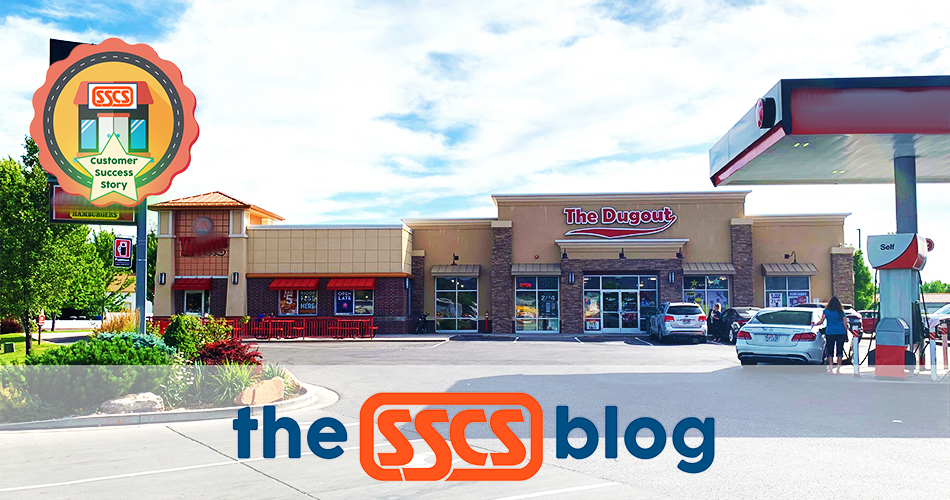
The Dug Out cleared up once cloudy performance metrics by applying SSCS Technology.
Note: This is Part 2 of a multi-part article. To begin with Part 1, please click here.
Unlocking the Secrets of C-Store Success
In the retail petroleum industry, most would tell you that technology and the convenience store go together hand in hand.
Honestly, though, that’s a generalization. There are plenty of stores that haven’t yet computerized. Some even experience a measure of success. Problem is, manually run stores growth either hit a ceiling or the opposite happens: the business spirals away from the operator’s control, leaving management swimming in potentially useful information it isn’t equipped to handle. It comes from the register, from vendors, from customers, and that’s only a start. This data is the source of c-store success—if it is unlocked and interpreted correctly.
As we saw last week, this kind of information overload had begun to plague the Barney Family, one of the most serious symptoms indicating that their store, the Dug Out, was going through some serious growing pains. Great customer service and a host of inventive Foodservice offerings had spurred increasing sales, but the store was hemorrhaging red ink nonetheless.
The reasons weren’t completely clear.
“When we started we thought we could gauge success based on gross sales and profit and now it wasn’t working at all,” says Austin Barney. “Foodservice, which should have been a blessing for the store, turned into a curse because we didn’t know the true cost of doing business. We started thinking of Foodservice as a loss leader, which shows you how topsy-turvy things had gotten.”
The successful convenience store operators with which Austin and his brother, Calvin consulted agreed that the use of a back office computer would clear up the murkiness surrounding the Dug Out’s performance. Most ideal would be a system that offered control over pricing and item-level inventory management. Austin and Calvin steered their family toward the idea—no other viable strategy to keep the store afloat had surfaced—and in the middle of 2018, the brothers began to technology shop.
Zero to 60 in a Heartbeat
Their search eventually led to SSCS sales representative, Shon Allen, who demonstrated a detailed familiarity with the scope of the transition facing the Barneys, painting a clear picture of the procedural discipline and best practices required to optimize computer use.
“It didn’t take long to realize that SSCS was knowledgeable not only in regard to their own technology, but in regard to the industry as a whole—big picture stuff Calvin and I needed to hear,” adds Austin. “Our confidence grew that SSCS would be present after the sale. A long-term relationship with our technology provider was essential to us since we were about to adapt to a more scientific way of doing business. So we decided to go with SSCS.”
Armed with confidence, Austin and Calvin went all in on SSCS Technology. They purchased the Computerized Daily Book (CDB) back office system, the Central Price Book (CPB) enterprise pricing solution, Hand-Held Data Processing (HDP) inventory scanning and management, as well as Transaction Analysis, with its steady feed of receipt-level transaction data from the POS. Austin and Calvin’s willingness to take the family store from zero to 60 in a heartbeat impressed SSCS.
“People hear about the Barneys and ask me how a relatively large operation went from no technology to all technology in a matter of months,” Allen explains. “It’s simple: they were totally committed. That makes all the difference. Sure there’s a learning curve, but if management and staff aren’t ready to embrace and adapt to the structure a computer imposes upon daily work, they won’t get the most out of their investment. It’s an important point that is often glossed over or ignored completely, but the Barneys got it.”
Austin and Calvin now found themselves in a position to delve into a brave new world of convenience store data. Their ability to get up to speed in a reasonable amount of time was not only a testament to their initiative, but to the preparation they received from SSCS.
“SSCS’s classroom training and especially the assistance SSCS provided during system installation added to our confidence as we came out of the gate,” Austin says. “They helped with tasks like scanning our items into the system at the item level. When the SSCS installation team made a suggestion, they always explained what they were doing, why, and what our store could expect going forward.”

Controlling Item Margins with EDI
As their familiarity with the SSCS solution set grew, Austin and Calvin got down to the business of poring over the numbers and values streaming in and out of the store as captured by SSCS Technology.
The brothers’ first order of business was getting control over item margins, and it didn’t take long for them to recognize the central role the CDB’s Electronic Data Interchange (EDI) module would play in the effort.
EDI delivers invoices in an electronic format from wholesale vendors to stores like the Dug Out via a private mailbox. Files are formatted so the CDB can read and accept them. Once the digital invoice is resident in the CDB, new items or cost changes are flagged, providing an up-to-the-minute look at cost dynamics.
The information was a mother lode of detail that allowed the brothers to proactively manage item profit margins continually over time.
“EDI placed a lot of pricing-related controls at our fingertips,” Austin says. “Comparing the hand invoice to the record of what was received electronically got us out ahead of potential issues. We could spot changes in vendor pricing before they got introduced into our inventory, which helped us hold down margin erosion. It gave us the option to either adjust our list prices accordingly before accepting the items or, in the case of potential pricing issues, engage with the vendor with documentation as support to clear up inconsistencies or errors.”
EDI provided other benefits for the Dug Out that extended beyond margin control, including the automatic creation of a paidout transaction and the ability to automatically schedule EDI conversions at a user-defined interval. These all represented huge time savings for a store that really needed it, and opened up opportunities for more SSCS-driven efficiencies which we’ll wrap up next week in the final part of this post.
Click here to continue to the third and final part of this story, a detailed look at SSCS Technology’s impact on the Dug Out.








Leave A Comment